Economics Assignment 1: Australian Dollar, Trade, and Economic Impact
VerifiedAdded on 2020/03/16
|14
|2782
|66
Homework Assignment
AI Summary
This economics assignment provides a detailed analysis of the Australian dollar's exchange rate, drawing upon an article from the Sydney Morning Herald and data from the Reserve Bank of Australia. The assignment explores the factors influencing the currency's value, including demand and supply dynamics in the foreign exchange market, and the impact of the Trade Weight Index. It examines the performance of the Australian dollar against the US dollar and its relation to commodity prices and global economic events. The assignment further investigates the implications of currency fluctuations on trade, specifically for an alcoholic beverage producer, and discusses strategies for currency devaluation. It covers various economic concepts, including overvaluation, export/import dynamics, and the role of the Reserve Bank of Australia in managing the exchange rate. Overall, the assignment offers a comprehensive overview of the Australian dollar's role in the global economy and its impact on various economic sectors.
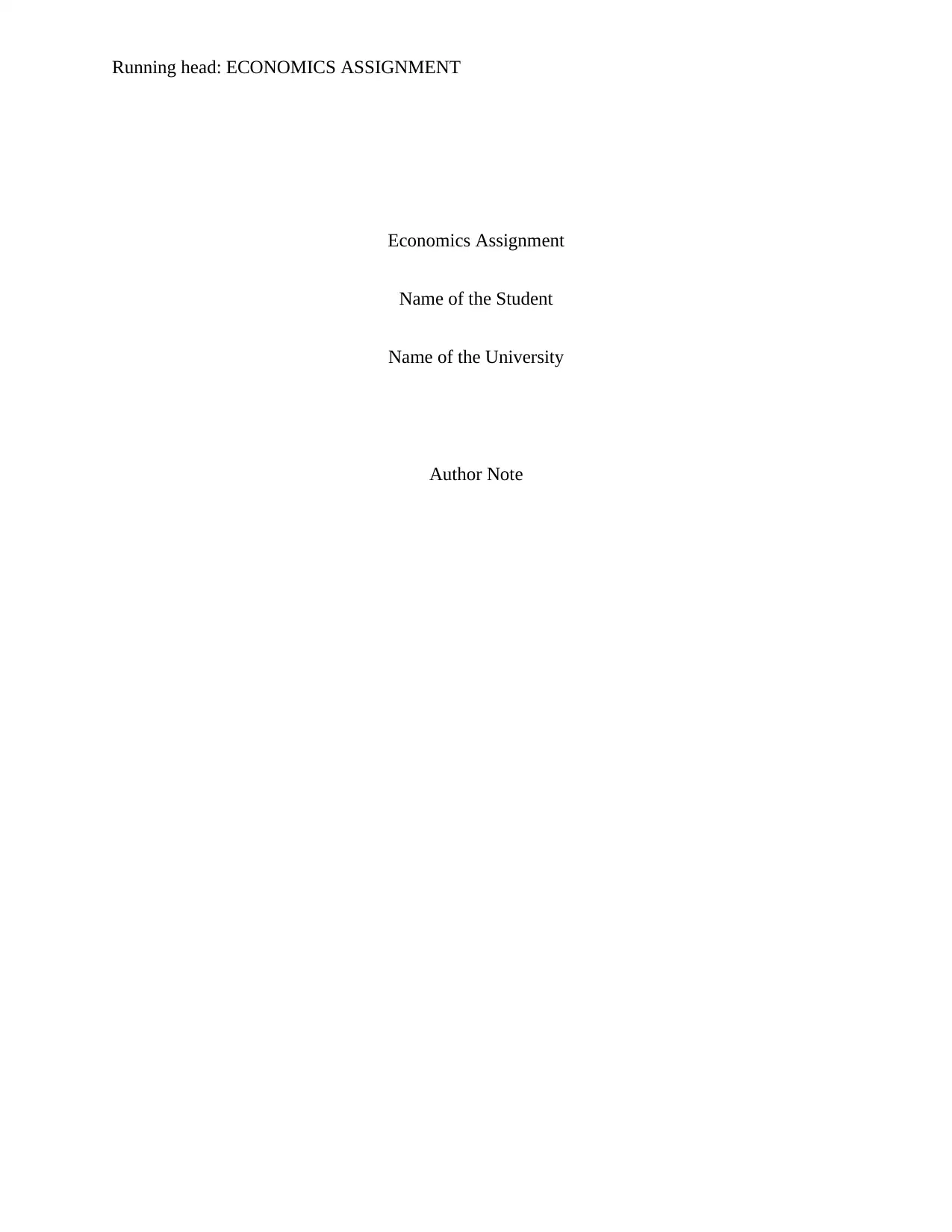
Running head: ECONOMICS ASSIGNMENT
Economics Assignment
Name of the Student
Name of the University
Author Note
Economics Assignment
Name of the Student
Name of the University
Author Note
Paraphrase This Document
Need a fresh take? Get an instant paraphrase of this document with our AI Paraphraser
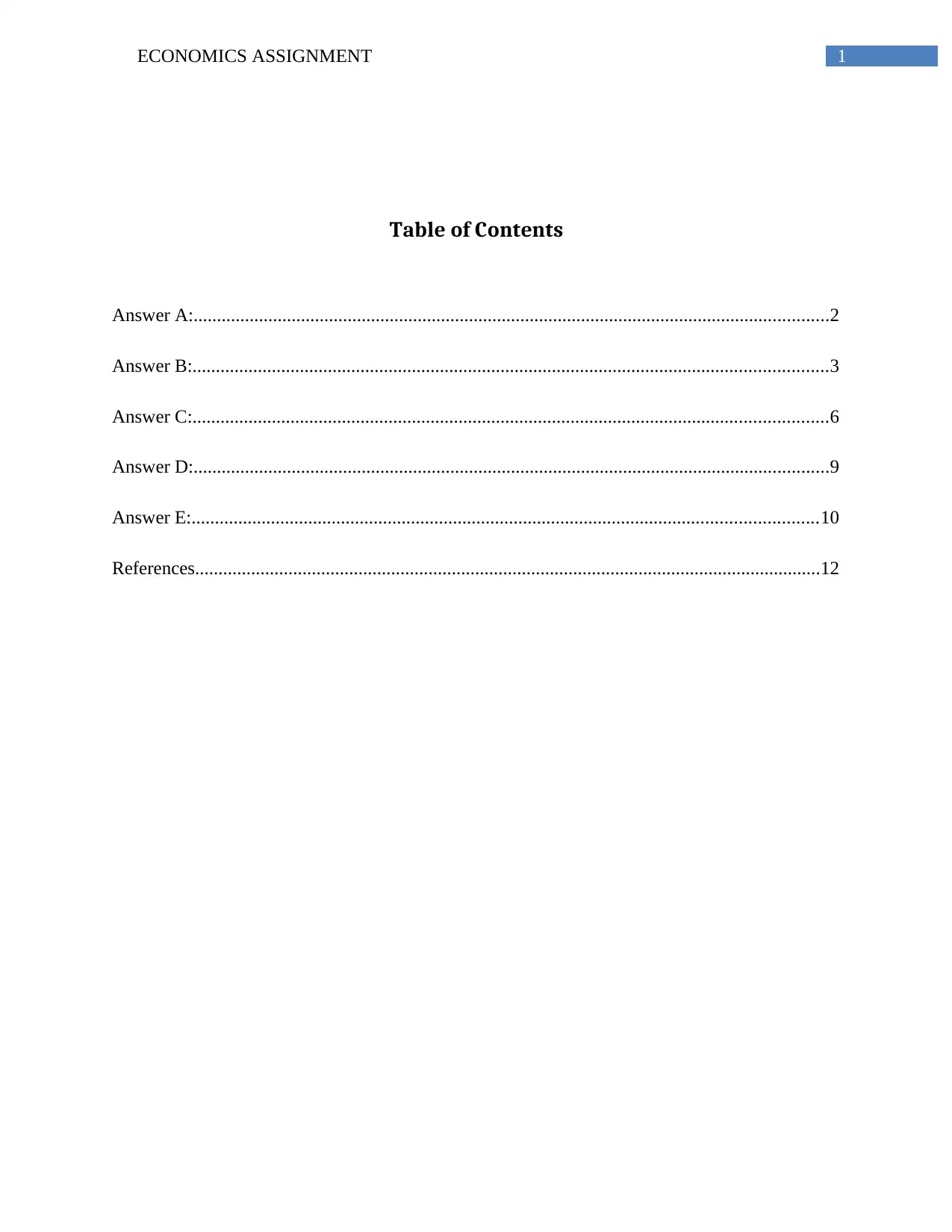
1ECONOMICS ASSIGNMENT
Table of Contents
Answer A:........................................................................................................................................2
Answer B:........................................................................................................................................3
Answer C:........................................................................................................................................6
Answer D:........................................................................................................................................9
Answer E:......................................................................................................................................10
References......................................................................................................................................12
Table of Contents
Answer A:........................................................................................................................................2
Answer B:........................................................................................................................................3
Answer C:........................................................................................................................................6
Answer D:........................................................................................................................................9
Answer E:......................................................................................................................................10
References......................................................................................................................................12
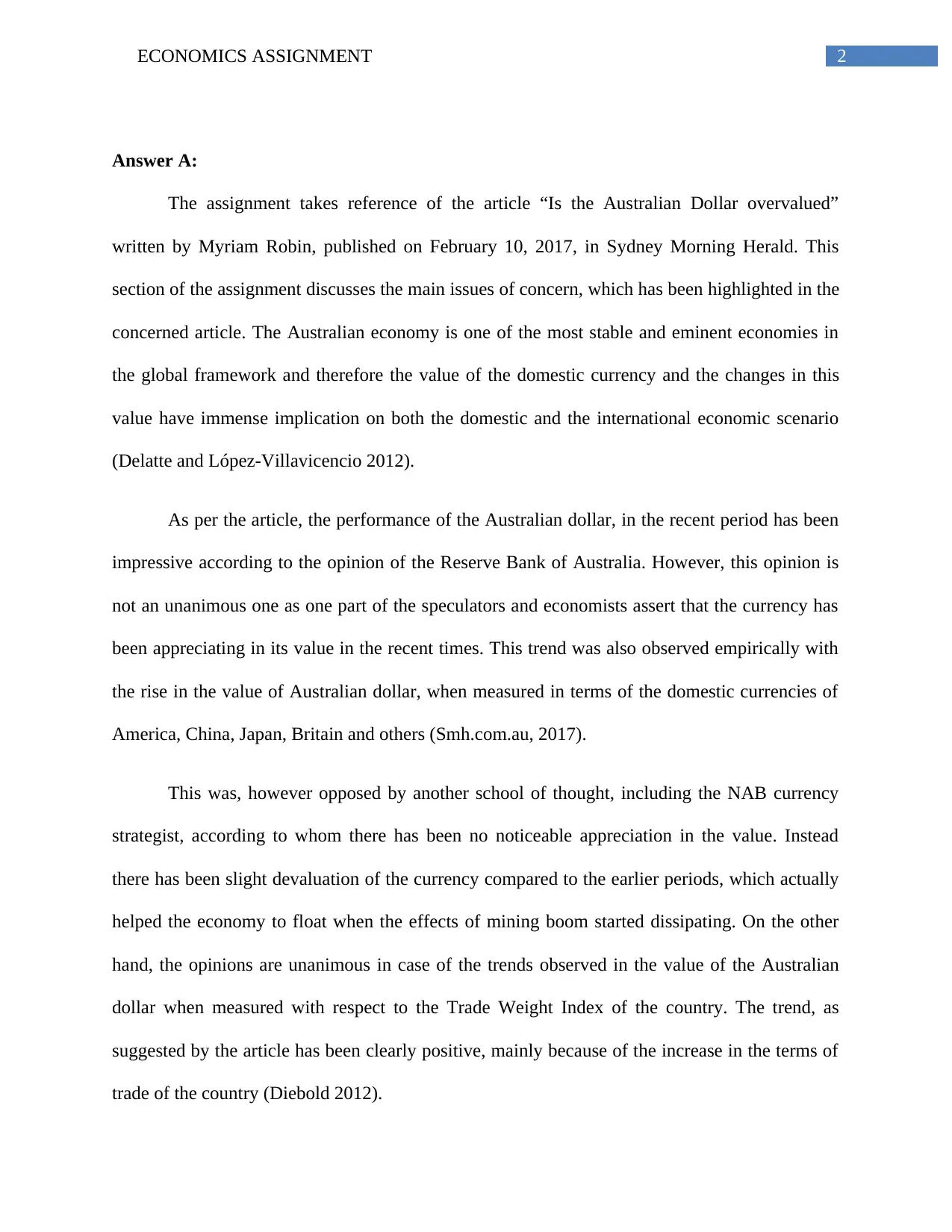
2ECONOMICS ASSIGNMENT
Answer A:
The assignment takes reference of the article “Is the Australian Dollar overvalued”
written by Myriam Robin, published on February 10, 2017, in Sydney Morning Herald. This
section of the assignment discusses the main issues of concern, which has been highlighted in the
concerned article. The Australian economy is one of the most stable and eminent economies in
the global framework and therefore the value of the domestic currency and the changes in this
value have immense implication on both the domestic and the international economic scenario
(Delatte and López-Villavicencio 2012).
As per the article, the performance of the Australian dollar, in the recent period has been
impressive according to the opinion of the Reserve Bank of Australia. However, this opinion is
not an unanimous one as one part of the speculators and economists assert that the currency has
been appreciating in its value in the recent times. This trend was also observed empirically with
the rise in the value of Australian dollar, when measured in terms of the domestic currencies of
America, China, Japan, Britain and others (Smh.com.au, 2017).
This was, however opposed by another school of thought, including the NAB currency
strategist, according to whom there has been no noticeable appreciation in the value. Instead
there has been slight devaluation of the currency compared to the earlier periods, which actually
helped the economy to float when the effects of mining boom started dissipating. On the other
hand, the opinions are unanimous in case of the trends observed in the value of the Australian
dollar when measured with respect to the Trade Weight Index of the country. The trend, as
suggested by the article has been clearly positive, mainly because of the increase in the terms of
trade of the country (Diebold 2012).
Answer A:
The assignment takes reference of the article “Is the Australian Dollar overvalued”
written by Myriam Robin, published on February 10, 2017, in Sydney Morning Herald. This
section of the assignment discusses the main issues of concern, which has been highlighted in the
concerned article. The Australian economy is one of the most stable and eminent economies in
the global framework and therefore the value of the domestic currency and the changes in this
value have immense implication on both the domestic and the international economic scenario
(Delatte and López-Villavicencio 2012).
As per the article, the performance of the Australian dollar, in the recent period has been
impressive according to the opinion of the Reserve Bank of Australia. However, this opinion is
not an unanimous one as one part of the speculators and economists assert that the currency has
been appreciating in its value in the recent times. This trend was also observed empirically with
the rise in the value of Australian dollar, when measured in terms of the domestic currencies of
America, China, Japan, Britain and others (Smh.com.au, 2017).
This was, however opposed by another school of thought, including the NAB currency
strategist, according to whom there has been no noticeable appreciation in the value. Instead
there has been slight devaluation of the currency compared to the earlier periods, which actually
helped the economy to float when the effects of mining boom started dissipating. On the other
hand, the opinions are unanimous in case of the trends observed in the value of the Australian
dollar when measured with respect to the Trade Weight Index of the country. The trend, as
suggested by the article has been clearly positive, mainly because of the increase in the terms of
trade of the country (Diebold 2012).
⊘ This is a preview!⊘
Do you want full access?
Subscribe today to unlock all pages.

Trusted by 1+ million students worldwide
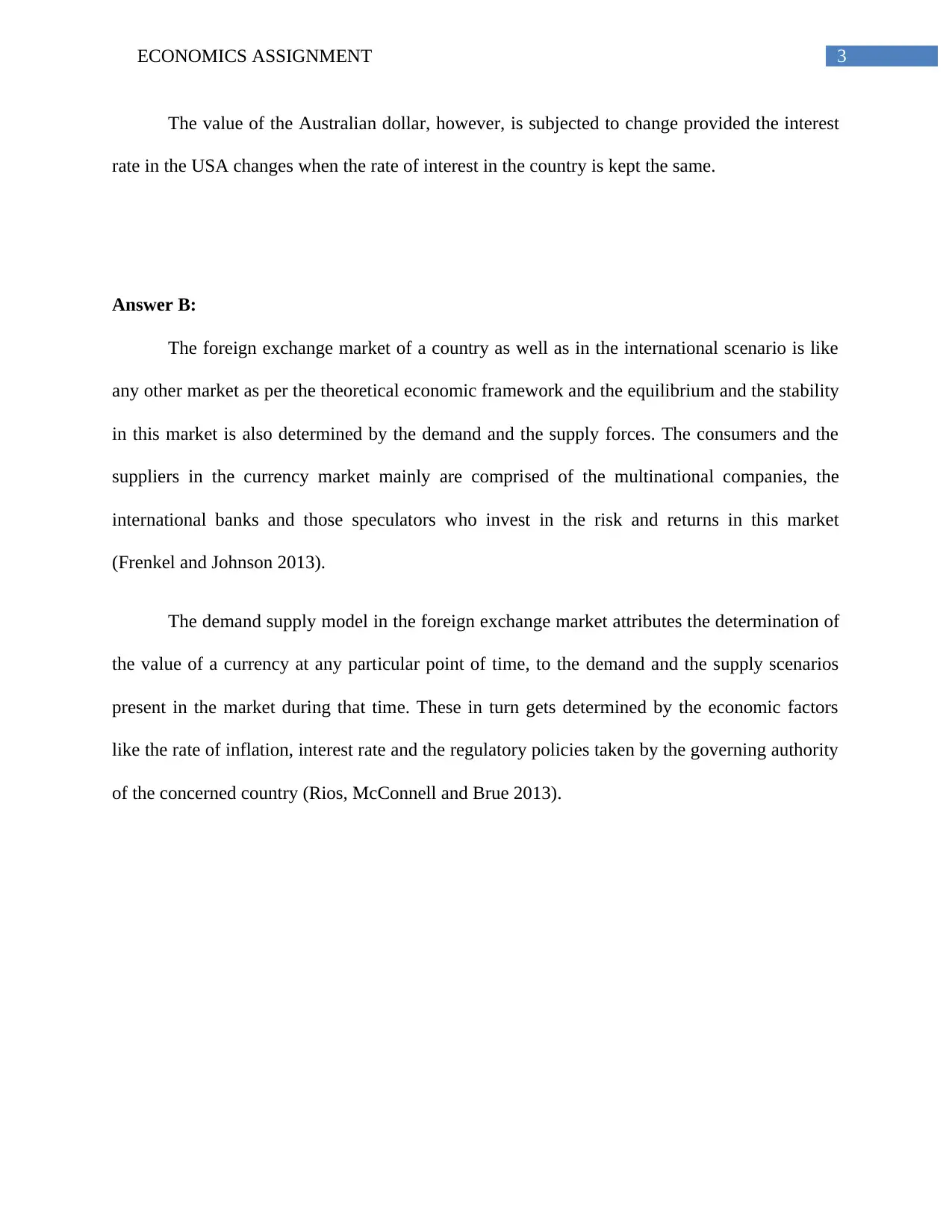
3ECONOMICS ASSIGNMENT
The value of the Australian dollar, however, is subjected to change provided the interest
rate in the USA changes when the rate of interest in the country is kept the same.
Answer B:
The foreign exchange market of a country as well as in the international scenario is like
any other market as per the theoretical economic framework and the equilibrium and the stability
in this market is also determined by the demand and the supply forces. The consumers and the
suppliers in the currency market mainly are comprised of the multinational companies, the
international banks and those speculators who invest in the risk and returns in this market
(Frenkel and Johnson 2013).
The demand supply model in the foreign exchange market attributes the determination of
the value of a currency at any particular point of time, to the demand and the supply scenarios
present in the market during that time. These in turn gets determined by the economic factors
like the rate of inflation, interest rate and the regulatory policies taken by the governing authority
of the concerned country (Rios, McConnell and Brue 2013).
The value of the Australian dollar, however, is subjected to change provided the interest
rate in the USA changes when the rate of interest in the country is kept the same.
Answer B:
The foreign exchange market of a country as well as in the international scenario is like
any other market as per the theoretical economic framework and the equilibrium and the stability
in this market is also determined by the demand and the supply forces. The consumers and the
suppliers in the currency market mainly are comprised of the multinational companies, the
international banks and those speculators who invest in the risk and returns in this market
(Frenkel and Johnson 2013).
The demand supply model in the foreign exchange market attributes the determination of
the value of a currency at any particular point of time, to the demand and the supply scenarios
present in the market during that time. These in turn gets determined by the economic factors
like the rate of inflation, interest rate and the regulatory policies taken by the governing authority
of the concerned country (Rios, McConnell and Brue 2013).
Paraphrase This Document
Need a fresh take? Get an instant paraphrase of this document with our AI Paraphraser
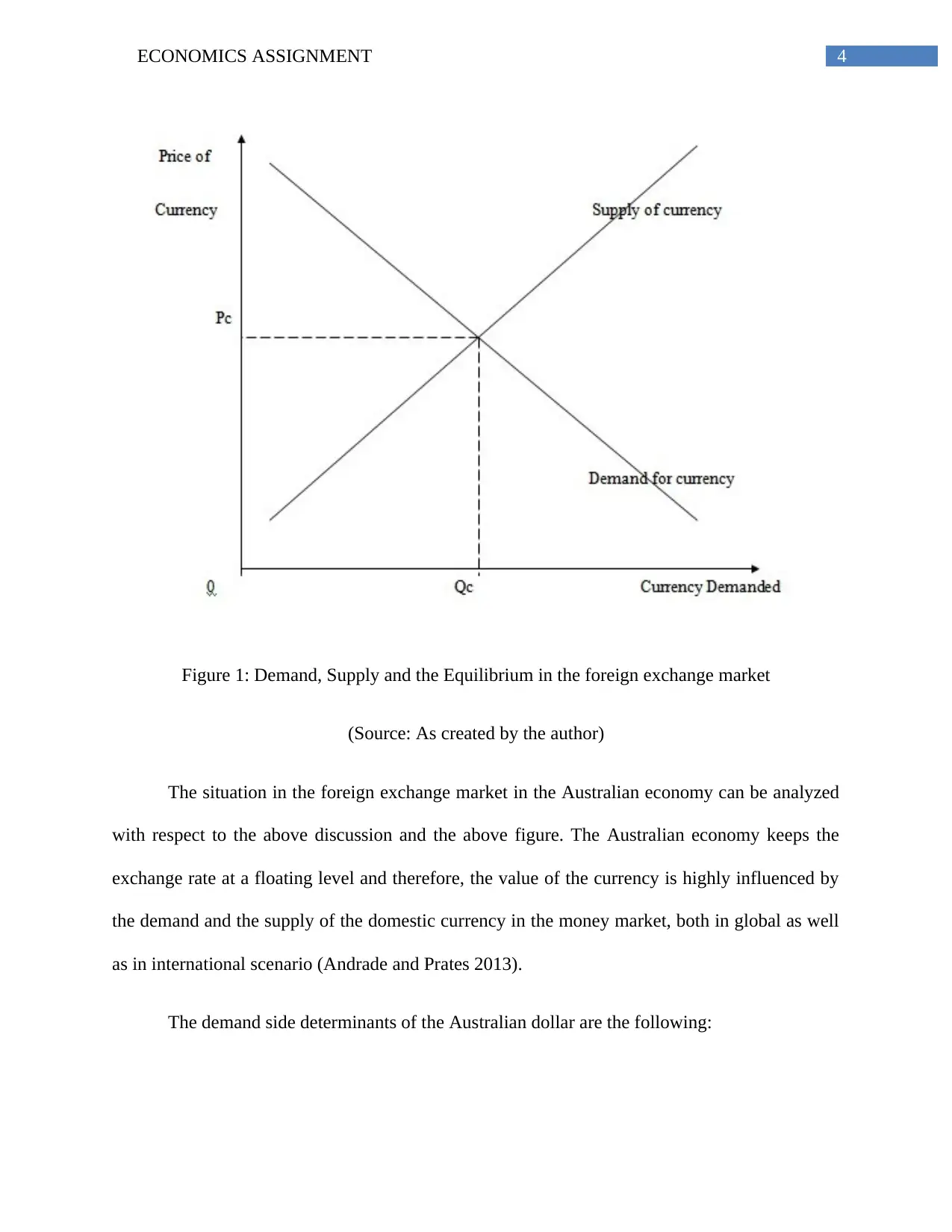
4ECONOMICS ASSIGNMENT
Figure 1: Demand, Supply and the Equilibrium in the foreign exchange market
(Source: As created by the author)
The situation in the foreign exchange market in the Australian economy can be analyzed
with respect to the above discussion and the above figure. The Australian economy keeps the
exchange rate at a floating level and therefore, the value of the currency is highly influenced by
the demand and the supply of the domestic currency in the money market, both in global as well
as in international scenario (Andrade and Prates 2013).
The demand side determinants of the Australian dollar are the following:
Figure 1: Demand, Supply and the Equilibrium in the foreign exchange market
(Source: As created by the author)
The situation in the foreign exchange market in the Australian economy can be analyzed
with respect to the above discussion and the above figure. The Australian economy keeps the
exchange rate at a floating level and therefore, the value of the currency is highly influenced by
the demand and the supply of the domestic currency in the money market, both in global as well
as in international scenario (Andrade and Prates 2013).
The demand side determinants of the Australian dollar are the following:
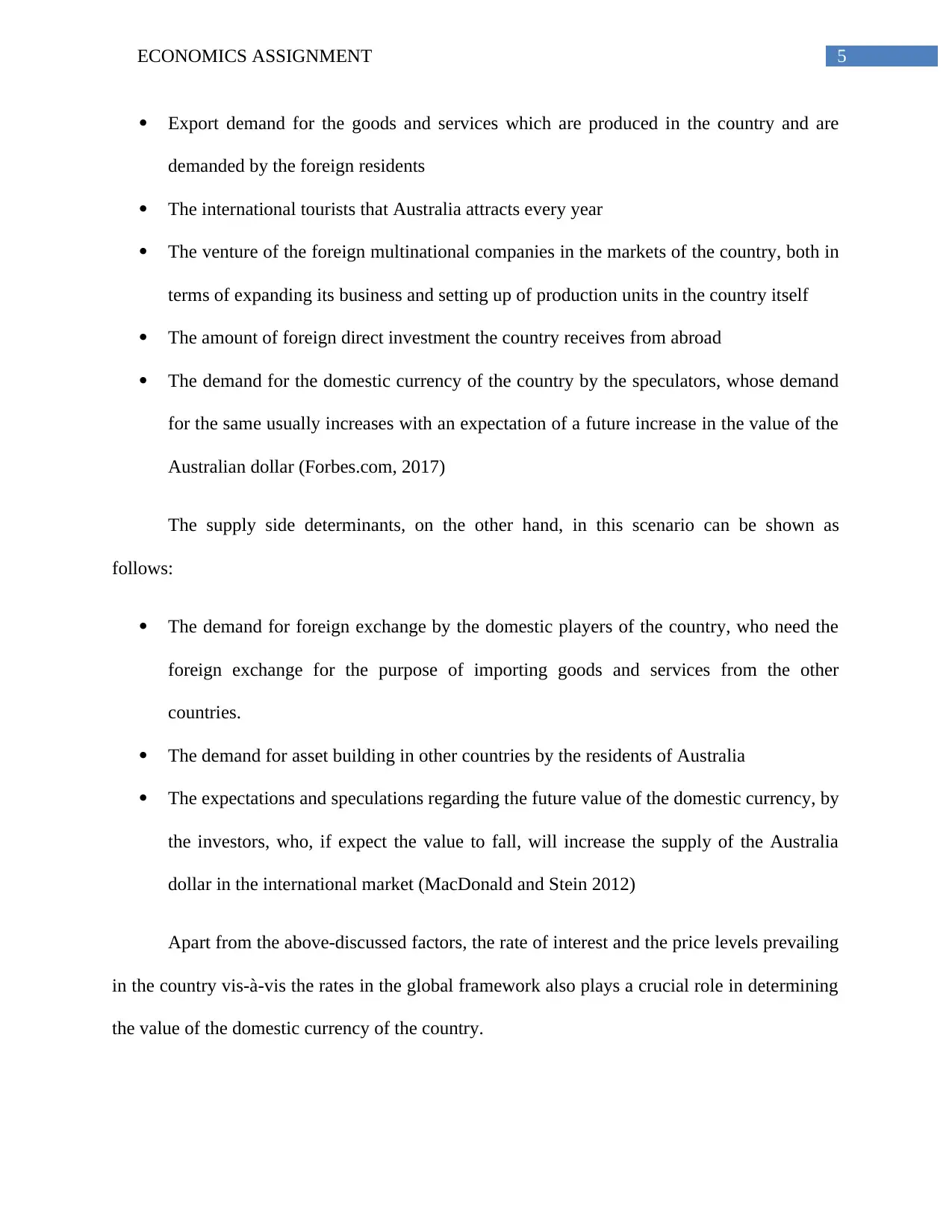
5ECONOMICS ASSIGNMENT
Export demand for the goods and services which are produced in the country and are
demanded by the foreign residents
The international tourists that Australia attracts every year
The venture of the foreign multinational companies in the markets of the country, both in
terms of expanding its business and setting up of production units in the country itself
The amount of foreign direct investment the country receives from abroad
The demand for the domestic currency of the country by the speculators, whose demand
for the same usually increases with an expectation of a future increase in the value of the
Australian dollar (Forbes.com, 2017)
The supply side determinants, on the other hand, in this scenario can be shown as
follows:
The demand for foreign exchange by the domestic players of the country, who need the
foreign exchange for the purpose of importing goods and services from the other
countries.
The demand for asset building in other countries by the residents of Australia
The expectations and speculations regarding the future value of the domestic currency, by
the investors, who, if expect the value to fall, will increase the supply of the Australia
dollar in the international market (MacDonald and Stein 2012)
Apart from the above-discussed factors, the rate of interest and the price levels prevailing
in the country vis-à-vis the rates in the global framework also plays a crucial role in determining
the value of the domestic currency of the country.
Export demand for the goods and services which are produced in the country and are
demanded by the foreign residents
The international tourists that Australia attracts every year
The venture of the foreign multinational companies in the markets of the country, both in
terms of expanding its business and setting up of production units in the country itself
The amount of foreign direct investment the country receives from abroad
The demand for the domestic currency of the country by the speculators, whose demand
for the same usually increases with an expectation of a future increase in the value of the
Australian dollar (Forbes.com, 2017)
The supply side determinants, on the other hand, in this scenario can be shown as
follows:
The demand for foreign exchange by the domestic players of the country, who need the
foreign exchange for the purpose of importing goods and services from the other
countries.
The demand for asset building in other countries by the residents of Australia
The expectations and speculations regarding the future value of the domestic currency, by
the investors, who, if expect the value to fall, will increase the supply of the Australia
dollar in the international market (MacDonald and Stein 2012)
Apart from the above-discussed factors, the rate of interest and the price levels prevailing
in the country vis-à-vis the rates in the global framework also plays a crucial role in determining
the value of the domestic currency of the country.
⊘ This is a preview!⊘
Do you want full access?
Subscribe today to unlock all pages.

Trusted by 1+ million students worldwide
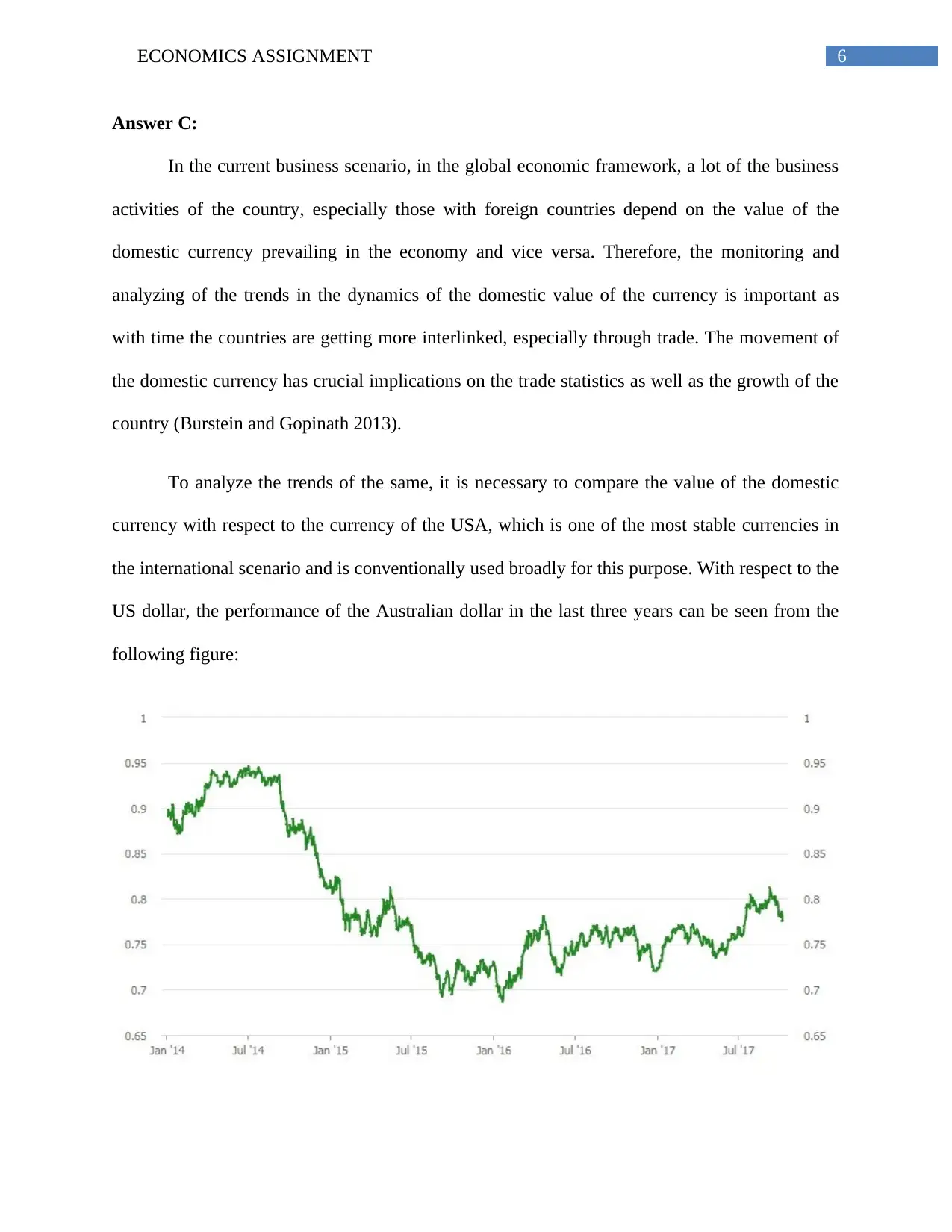
6ECONOMICS ASSIGNMENT
Answer C:
In the current business scenario, in the global economic framework, a lot of the business
activities of the country, especially those with foreign countries depend on the value of the
domestic currency prevailing in the economy and vice versa. Therefore, the monitoring and
analyzing of the trends in the dynamics of the domestic value of the currency is important as
with time the countries are getting more interlinked, especially through trade. The movement of
the domestic currency has crucial implications on the trade statistics as well as the growth of the
country (Burstein and Gopinath 2013).
To analyze the trends of the same, it is necessary to compare the value of the domestic
currency with respect to the currency of the USA, which is one of the most stable currencies in
the international scenario and is conventionally used broadly for this purpose. With respect to the
US dollar, the performance of the Australian dollar in the last three years can be seen from the
following figure:
Answer C:
In the current business scenario, in the global economic framework, a lot of the business
activities of the country, especially those with foreign countries depend on the value of the
domestic currency prevailing in the economy and vice versa. Therefore, the monitoring and
analyzing of the trends in the dynamics of the domestic value of the currency is important as
with time the countries are getting more interlinked, especially through trade. The movement of
the domestic currency has crucial implications on the trade statistics as well as the growth of the
country (Burstein and Gopinath 2013).
To analyze the trends of the same, it is necessary to compare the value of the domestic
currency with respect to the currency of the USA, which is one of the most stable currencies in
the international scenario and is conventionally used broadly for this purpose. With respect to the
US dollar, the performance of the Australian dollar in the last three years can be seen from the
following figure:
Paraphrase This Document
Need a fresh take? Get an instant paraphrase of this document with our AI Paraphraser
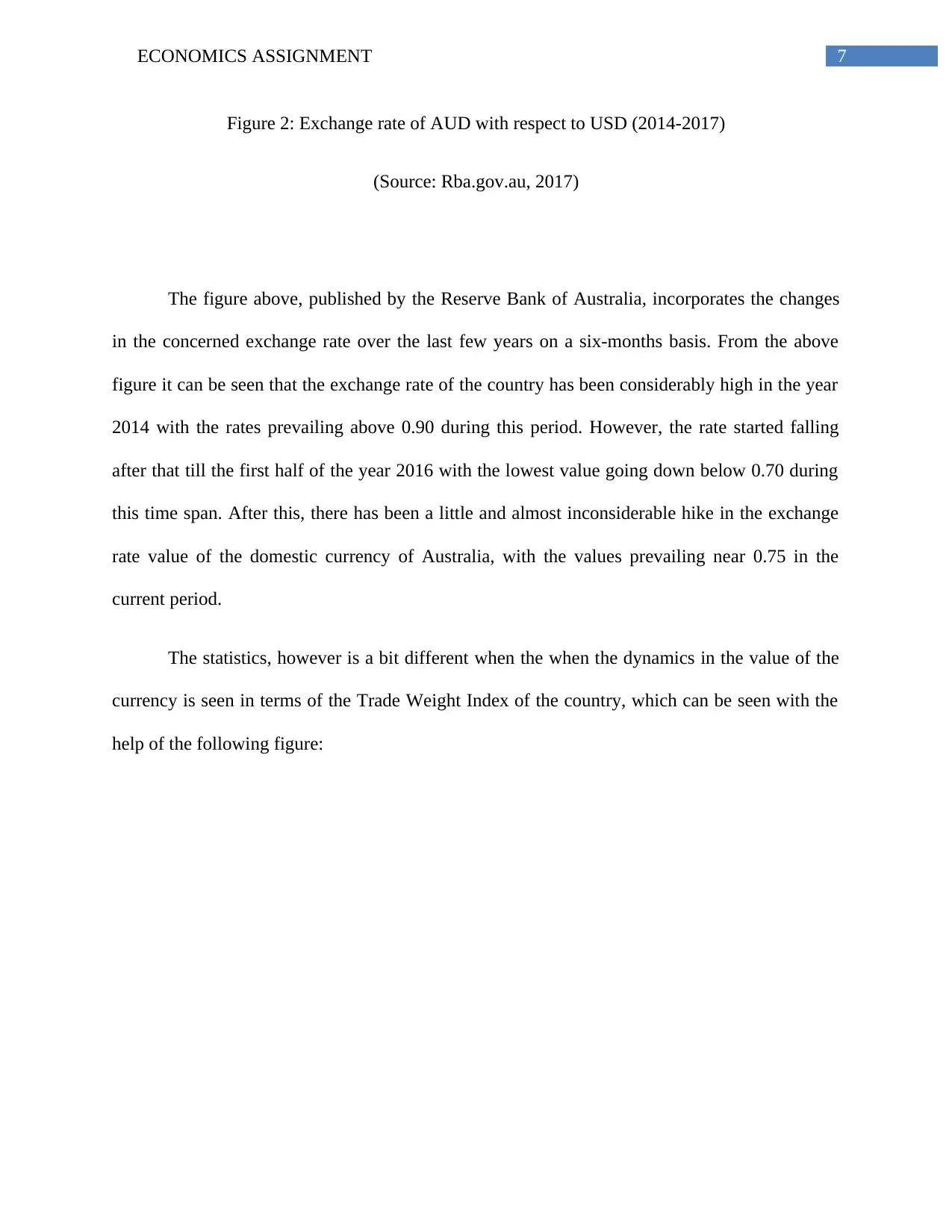
7ECONOMICS ASSIGNMENT
Figure 2: Exchange rate of AUD with respect to USD (2014-2017)
(Source: Rba.gov.au, 2017)
The figure above, published by the Reserve Bank of Australia, incorporates the changes
in the concerned exchange rate over the last few years on a six-months basis. From the above
figure it can be seen that the exchange rate of the country has been considerably high in the year
2014 with the rates prevailing above 0.90 during this period. However, the rate started falling
after that till the first half of the year 2016 with the lowest value going down below 0.70 during
this time span. After this, there has been a little and almost inconsiderable hike in the exchange
rate value of the domestic currency of Australia, with the values prevailing near 0.75 in the
current period.
The statistics, however is a bit different when the when the dynamics in the value of the
currency is seen in terms of the Trade Weight Index of the country, which can be seen with the
help of the following figure:
Figure 2: Exchange rate of AUD with respect to USD (2014-2017)
(Source: Rba.gov.au, 2017)
The figure above, published by the Reserve Bank of Australia, incorporates the changes
in the concerned exchange rate over the last few years on a six-months basis. From the above
figure it can be seen that the exchange rate of the country has been considerably high in the year
2014 with the rates prevailing above 0.90 during this period. However, the rate started falling
after that till the first half of the year 2016 with the lowest value going down below 0.70 during
this time span. After this, there has been a little and almost inconsiderable hike in the exchange
rate value of the domestic currency of Australia, with the values prevailing near 0.75 in the
current period.
The statistics, however is a bit different when the when the dynamics in the value of the
currency is seen in terms of the Trade Weight Index of the country, which can be seen with the
help of the following figure:
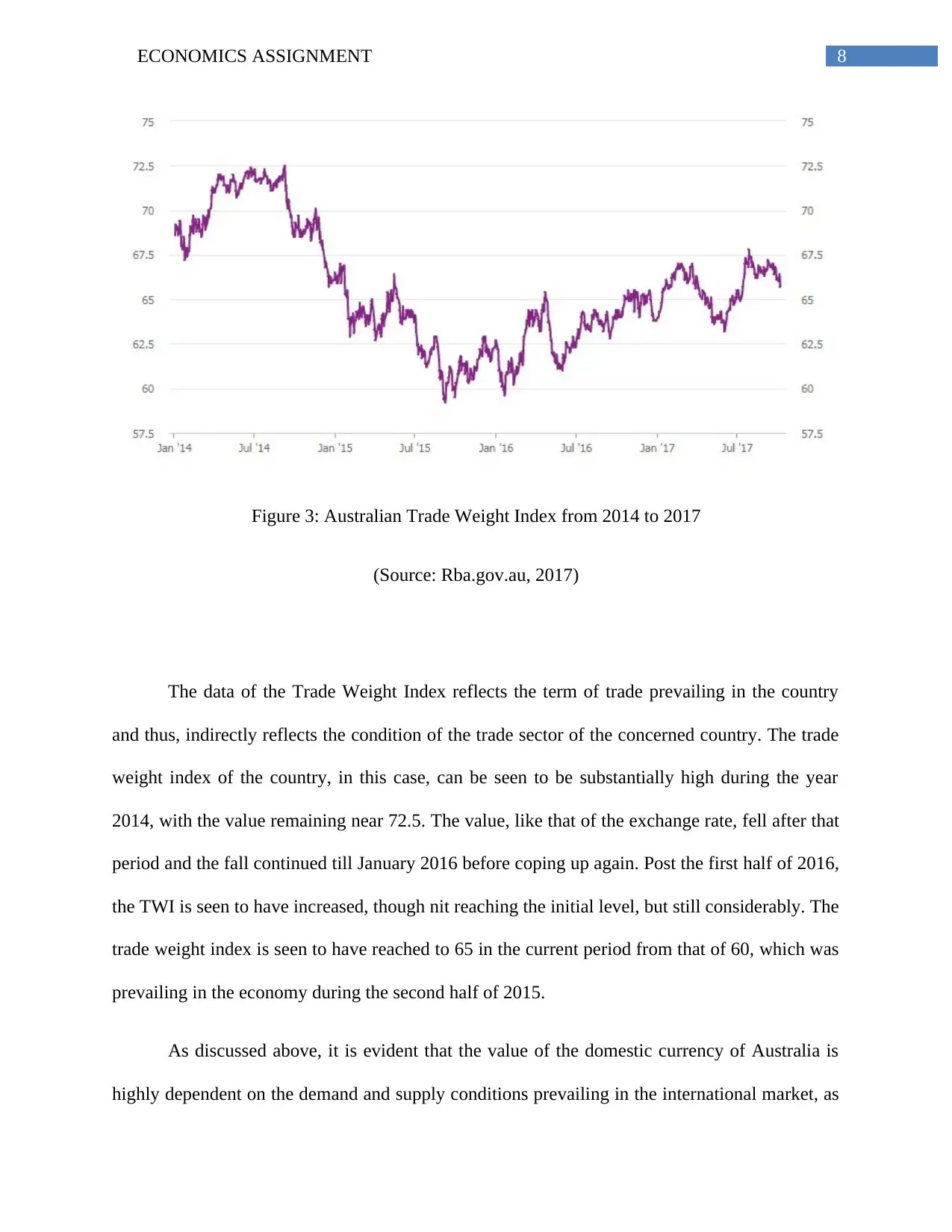
8ECONOMICS ASSIGNMENT
Figure 3: Australian Trade Weight Index from 2014 to 2017
(Source: Rba.gov.au, 2017)
The data of the Trade Weight Index reflects the term of trade prevailing in the country
and thus, indirectly reflects the condition of the trade sector of the concerned country. The trade
weight index of the country, in this case, can be seen to be substantially high during the year
2014, with the value remaining near 72.5. The value, like that of the exchange rate, fell after that
period and the fall continued till January 2016 before coping up again. Post the first half of 2016,
the TWI is seen to have increased, though nit reaching the initial level, but still considerably. The
trade weight index is seen to have reached to 65 in the current period from that of 60, which was
prevailing in the economy during the second half of 2015.
As discussed above, it is evident that the value of the domestic currency of Australia is
highly dependent on the demand and supply conditions prevailing in the international market, as
Figure 3: Australian Trade Weight Index from 2014 to 2017
(Source: Rba.gov.au, 2017)
The data of the Trade Weight Index reflects the term of trade prevailing in the country
and thus, indirectly reflects the condition of the trade sector of the concerned country. The trade
weight index of the country, in this case, can be seen to be substantially high during the year
2014, with the value remaining near 72.5. The value, like that of the exchange rate, fell after that
period and the fall continued till January 2016 before coping up again. Post the first half of 2016,
the TWI is seen to have increased, though nit reaching the initial level, but still considerably. The
trade weight index is seen to have reached to 65 in the current period from that of 60, which was
prevailing in the economy during the second half of 2015.
As discussed above, it is evident that the value of the domestic currency of Australia is
highly dependent on the demand and supply conditions prevailing in the international market, as
⊘ This is a preview!⊘
Do you want full access?
Subscribe today to unlock all pages.

Trusted by 1+ million students worldwide
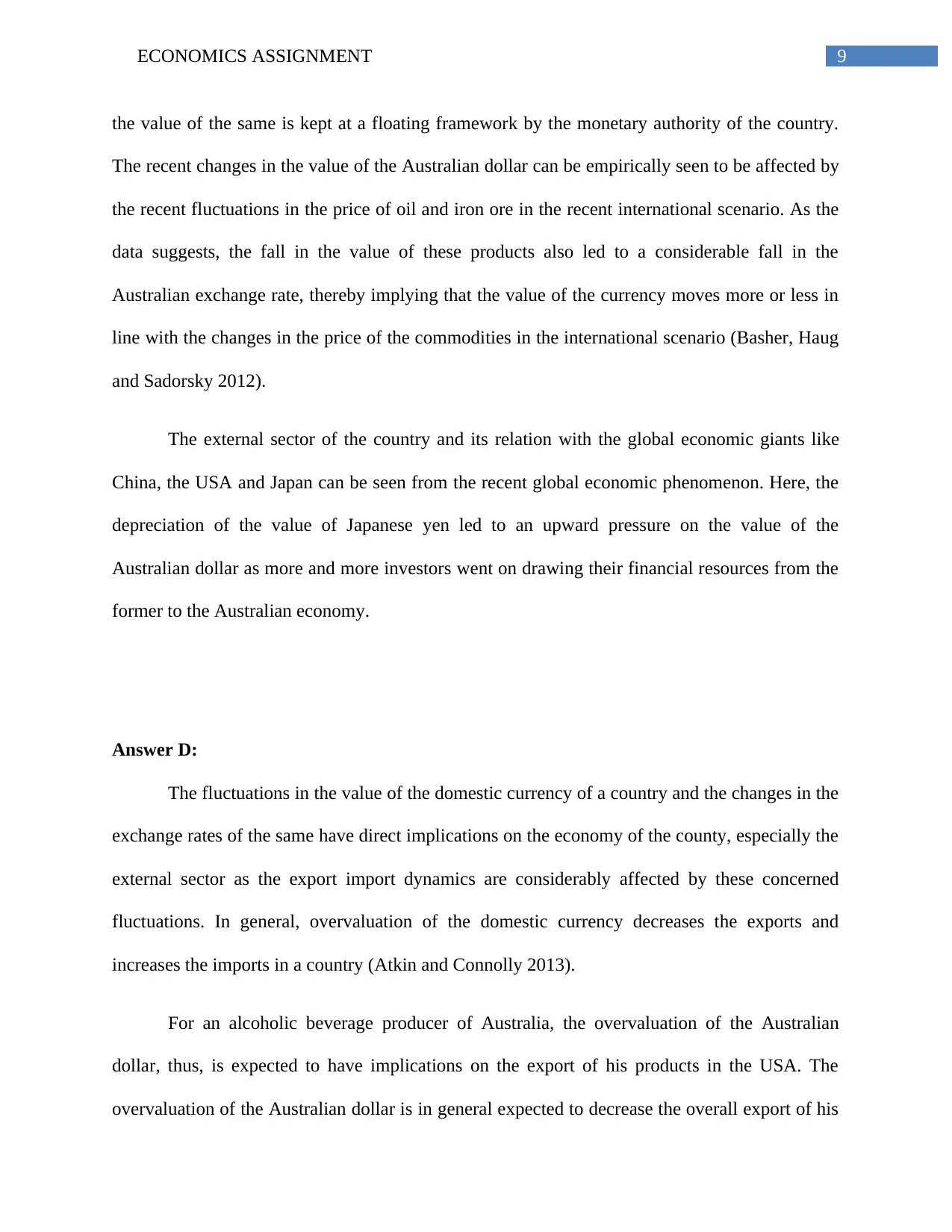
9ECONOMICS ASSIGNMENT
the value of the same is kept at a floating framework by the monetary authority of the country.
The recent changes in the value of the Australian dollar can be empirically seen to be affected by
the recent fluctuations in the price of oil and iron ore in the recent international scenario. As the
data suggests, the fall in the value of these products also led to a considerable fall in the
Australian exchange rate, thereby implying that the value of the currency moves more or less in
line with the changes in the price of the commodities in the international scenario (Basher, Haug
and Sadorsky 2012).
The external sector of the country and its relation with the global economic giants like
China, the USA and Japan can be seen from the recent global economic phenomenon. Here, the
depreciation of the value of Japanese yen led to an upward pressure on the value of the
Australian dollar as more and more investors went on drawing their financial resources from the
former to the Australian economy.
Answer D:
The fluctuations in the value of the domestic currency of a country and the changes in the
exchange rates of the same have direct implications on the economy of the county, especially the
external sector as the export import dynamics are considerably affected by these concerned
fluctuations. In general, overvaluation of the domestic currency decreases the exports and
increases the imports in a country (Atkin and Connolly 2013).
For an alcoholic beverage producer of Australia, the overvaluation of the Australian
dollar, thus, is expected to have implications on the export of his products in the USA. The
overvaluation of the Australian dollar is in general expected to decrease the overall export of his
the value of the same is kept at a floating framework by the monetary authority of the country.
The recent changes in the value of the Australian dollar can be empirically seen to be affected by
the recent fluctuations in the price of oil and iron ore in the recent international scenario. As the
data suggests, the fall in the value of these products also led to a considerable fall in the
Australian exchange rate, thereby implying that the value of the currency moves more or less in
line with the changes in the price of the commodities in the international scenario (Basher, Haug
and Sadorsky 2012).
The external sector of the country and its relation with the global economic giants like
China, the USA and Japan can be seen from the recent global economic phenomenon. Here, the
depreciation of the value of Japanese yen led to an upward pressure on the value of the
Australian dollar as more and more investors went on drawing their financial resources from the
former to the Australian economy.
Answer D:
The fluctuations in the value of the domestic currency of a country and the changes in the
exchange rates of the same have direct implications on the economy of the county, especially the
external sector as the export import dynamics are considerably affected by these concerned
fluctuations. In general, overvaluation of the domestic currency decreases the exports and
increases the imports in a country (Atkin and Connolly 2013).
For an alcoholic beverage producer of Australia, the overvaluation of the Australian
dollar, thus, is expected to have implications on the export of his products in the USA. The
overvaluation of the Australian dollar is in general expected to decrease the overall export of his
Paraphrase This Document
Need a fresh take? Get an instant paraphrase of this document with our AI Paraphraser

10ECONOMICS ASSIGNMENT
product to the USA. However, by how much the export of his product will decrease depends on
the type of alcoholic beverage he is selling, as the demand for beer in the USA is much higher
and inelastic than the demand for other types of alcoholic beverages (Michie et al. 2012).
However, in an overall framework, as alcoholic beverage does not fall under the domain
of necessary goods, the overvaluation of the domestic currency will make the product more
costly to the foreign nationals and thus will decrease the demand, thereby leading to a fall in the
revenue of the concerned alcohol producer.
Effects on the overall economy of Australia:
Apart from increasing the import and decreasing the exports of the country, the
overvaluation of the Australian currency also leads to increase in the aggregate import demand in
the country with an increase in the purchasing power in the hands of the residents of the country.
The overvaluation of the domestic currency in the Australian economy also affects the
investment scenario, both by the domestic investors in the foreign market and by the foreign
investors in the domestic market (Schulmeister 2013).
Answer E:
As has been asked in the concerned question, to bring down the exchange rate in the
Australian market, from US 76 C to US 72C, the governing authority has to embark on the
process of evaluation of the domestic currency. This process involves mainly the release of the
domestic currency in the international market, which can be done by activities like dumping and
printing of the money. The imports in the country can be increased and restrictions can be
product to the USA. However, by how much the export of his product will decrease depends on
the type of alcoholic beverage he is selling, as the demand for beer in the USA is much higher
and inelastic than the demand for other types of alcoholic beverages (Michie et al. 2012).
However, in an overall framework, as alcoholic beverage does not fall under the domain
of necessary goods, the overvaluation of the domestic currency will make the product more
costly to the foreign nationals and thus will decrease the demand, thereby leading to a fall in the
revenue of the concerned alcohol producer.
Effects on the overall economy of Australia:
Apart from increasing the import and decreasing the exports of the country, the
overvaluation of the Australian currency also leads to increase in the aggregate import demand in
the country with an increase in the purchasing power in the hands of the residents of the country.
The overvaluation of the domestic currency in the Australian economy also affects the
investment scenario, both by the domestic investors in the foreign market and by the foreign
investors in the domestic market (Schulmeister 2013).
Answer E:
As has been asked in the concerned question, to bring down the exchange rate in the
Australian market, from US 76 C to US 72C, the governing authority has to embark on the
process of evaluation of the domestic currency. This process involves mainly the release of the
domestic currency in the international market, which can be done by activities like dumping and
printing of the money. The imports in the country can be increased and restrictions can be
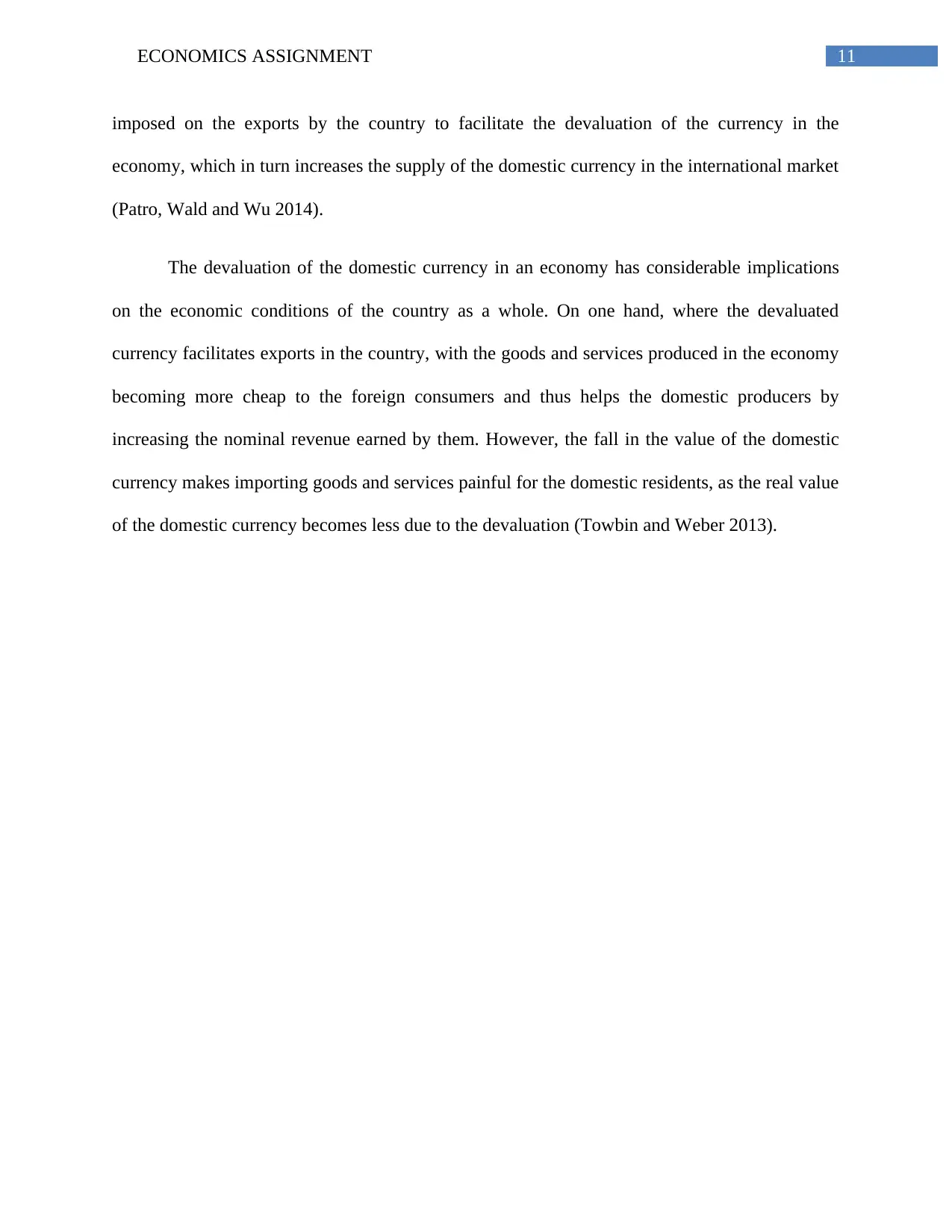
11ECONOMICS ASSIGNMENT
imposed on the exports by the country to facilitate the devaluation of the currency in the
economy, which in turn increases the supply of the domestic currency in the international market
(Patro, Wald and Wu 2014).
The devaluation of the domestic currency in an economy has considerable implications
on the economic conditions of the country as a whole. On one hand, where the devaluated
currency facilitates exports in the country, with the goods and services produced in the economy
becoming more cheap to the foreign consumers and thus helps the domestic producers by
increasing the nominal revenue earned by them. However, the fall in the value of the domestic
currency makes importing goods and services painful for the domestic residents, as the real value
of the domestic currency becomes less due to the devaluation (Towbin and Weber 2013).
imposed on the exports by the country to facilitate the devaluation of the currency in the
economy, which in turn increases the supply of the domestic currency in the international market
(Patro, Wald and Wu 2014).
The devaluation of the domestic currency in an economy has considerable implications
on the economic conditions of the country as a whole. On one hand, where the devaluated
currency facilitates exports in the country, with the goods and services produced in the economy
becoming more cheap to the foreign consumers and thus helps the domestic producers by
increasing the nominal revenue earned by them. However, the fall in the value of the domestic
currency makes importing goods and services painful for the domestic residents, as the real value
of the domestic currency becomes less due to the devaluation (Towbin and Weber 2013).
⊘ This is a preview!⊘
Do you want full access?
Subscribe today to unlock all pages.

Trusted by 1+ million students worldwide
1 out of 14
Related Documents
Your All-in-One AI-Powered Toolkit for Academic Success.
+13062052269
info@desklib.com
Available 24*7 on WhatsApp / Email
![[object Object]](/_next/static/media/star-bottom.7253800d.svg)
Unlock your academic potential
Copyright © 2020–2025 A2Z Services. All Rights Reserved. Developed and managed by ZUCOL.





